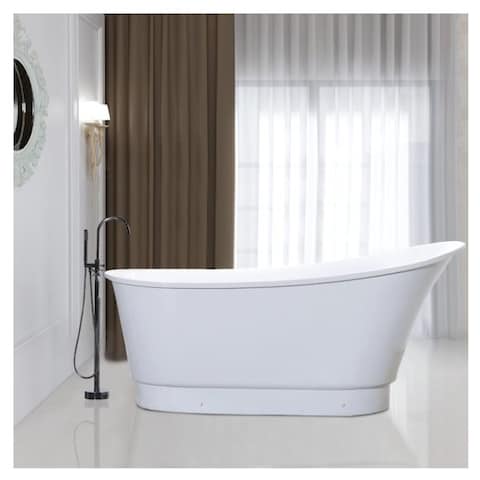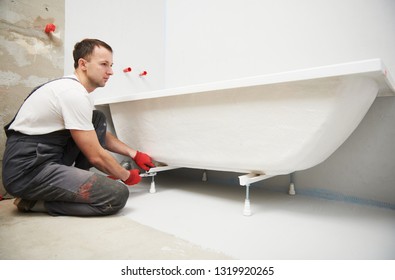Can I Set Up A Tub Myself?
Can I Set Up A Tub Myself?
Blog Article
We've encountered this article pertaining to A Step-by-Step Guide to Installing a Bathtub below on the net and figured it made perfect sense to relate it with you on my blog.

Mounting a bathtub isn't specifically rocket science, however it does call for strong plumbing, carpentry, as well as often, tiling abilities. Replacing an old tub with a brand-new one is additionally a moderately challenging task. If the old bathtub is readily available, the job can relocate speedily; if you have to open a wall surface to get rid of the old bathtub and position the brand-new bath tub, the task is a lot harder. In either instance, the task is within a residence handyman's abilities, although you will need a helper to leave the old bathtub and also embeded in the new one. Make sure you have qualified on your own for the work and also fit attempting it. Rather than hiring a specialist to take control of a halfway-completed task, it is far better to take into consideration using one before you start. Opportunities are you might require a specialist plumber to make tube links.
This post will help you install a new tub in your washroom if you have actually currently acquired a brand-new bathtub as well as do not require to alter the plan of your previous water supply pipes.
Your tools as well as product list must consist of the following:
Removing Old Touches
If you require to change old faucets with brand-new ones as a part of your installment, after that the first thing you need to do is separate the water. After doing so, activate the faucets to drain pipes any kind of water continuing to be in the system. The procedure of getting rid of the existing faucets can be fairly problematic due to the restricted accessibility that is usually the instance.
Make use of a basin wrench (crowsfoot spanner) or a tap tool to reverse the nut that attaches the supply pipelines to the taps. Have a cloth all set for the continuing to be water that will certainly come from the pipes. As soon as the supply pipelines have been removed, make use of the exact same tool to loosen the nut that holds the faucets onto the bath/basin. You will certainly require to stop the single faucets from transforming during this process. As soon as the taps have actually been eliminated, the holes in the bath/basin will need to be cleaned up of any type of old sealing substance.
Before moving on to fit the brand-new taps, contrast the pipe connections on the old faucets to the new taps. If the old faucets are longer than the new faucets, after that a shank adapter is required for the new faucets to fit.
Suitable New Taps
If the tails of the brand-new taps are plastic, then you will certainly need a plastic port to prevent damage to the string. One end of the port fits on the plastic tail of the tap and also the other end gives a connection to the existent supply pipelines.
If you need to fit a monobloc, after that you will call for decreasing couplers, which connects the 10mm pipeline of the monobloc to the basic 15mm supply pipeline.
Next, place the faucet in the installing opening in the bath/basin making sure that the washers remain in place in between the tap and the sink. Safeguard the tap in position with the producer given backnut. Once the faucet is securely in position, the supply pipes can be linked to the tails of the taps. The taps can either be attached by using corrugated copper piping or with regular tap ports. The former type needs to be linked to the tap finishes first, tightening just by hand. The supply pipes can later on be attached to the other end. Tighten both ends with a spanner after both ends have actually been connected.
Setting up the Bath tub
Utilizing both wooden boards under its feet, put the bath tub in the required setting. The wood boards are useful in uniformly spreading the weight of the tub over the location of the boards instead of focusing all the weight onto 4 tiny points.
The following goal is to make certain that the bathtub is leveled all round. This can be accomplished by inspecting the level and also adjusting the feet on the tub till the spirit level reads level.
To set up faucets, fit all-time low of the furthest versatile faucet adapter to the appropriate supply pipe by making a compression sign up with; after that do the same for the other tap.
Turn on the water and check all joints as well as new pipework for leaks as well as tighten them if needed. Load the bath tub as well as also check the overflow outlet and the typical electrical outlet for leakages.
Ultimately, fix the bath paneling as described in the supplier's instruction manual. Tiling as well as securing around the bath tub needs to wait till the bath tub has been used at the very least when as this will settle it into its final setting.
Planning for the Installment
Firstly, the supporting framework supplied with the bathroom needs to be fitted (if called for) according to the manufacturer's instructions. Next, fit the taps or mixer to the tub. When suitable the faucet block, it is necessary to see to it that if the tap comes with a plastic washer, it is fitted between the bath as well as the taps. On a plastic bath, it is additionally reasonable to fit a sustaining plate under the faucets unit to prevent pressure on the bath tub.
Fit the adaptable faucet ports to the bottom of the two taps using 2 nuts and olives (often supplied with the tub). Fit the plug-hole outlet by smearing mastic filler round the sink electrical outlet opening, and after that pass the outlet with the hole in the bath. Make use of the nut provided by the maker to fit the plug-hole. Take a look at the plug-hole outlet for an inlet on the side for the overflow pipe.
Next off, fit the end of the flexible overflow pipeline to the overflow outlet. After that, screw the pipeline to the overflow face which ought to be fitted inside the bath. See to it you utilize all of the provided washers.
Attach the catch to the bottom of the waste outlet on the bathtub by winding the string of the waste electrical outlet with silicone mastic or PTFE tape, and screw on the catch to the outlet. Attach all-time low of the overflow tube in a similar manner.The bathroom ought to currently be ready to be fitted in its last position.
Tiling Around the Bath tub
In the area where the bath satisfies the tile, it is needed to seal the accompanies a silicone rubber caulking. This is essential as the installation can move sufficient to break an inflexible seal, triggering the water to penetrate the wall surface between the bathroom and also the tiling, causing difficulties with moisture and also possible leakages to the ceiling below.
You can pick from a variety of coloured sealers to blend in your components and installations. They are sold in tubes as well as cartridges, and also are capable of securing gaps as much as a width of 3mm (1/8 inch). If you have a larger void to fill, you can load it with spins of soaked paper or soft rope. Remember to constantly load the bathtub with water prior to securing, to allow for the motion experienced when the tub is in usage. The sealer can break rather early if you do not take into consideration this activity before securing.
Conversely, ceramic coving or quadrant floor tiles can be used to border the bath or shower tray. Plastic strips of coving, which are easy to use as well as reduce to size, are likewise easily offered on the marketplace. It is recommended to fit the floor tiles using water-resistant or water-proof adhesive as well as cement.
Bathtub Installation
How Important Is A Bathtub To Your Home?
High-quality baths, showers, and other bathroom updates are necessary when considering a smart investment in your home. It’s a room that you go to every day and one that is constantly being used by guests.The bathroom is one of the top trafficked rooms in a home and also one of the most valuable in terms of home resale.
Install Piping Before Tub
You will be using your existing drain and waste vent system, but pipes required include the hot and cold water supply lines and a pipe leading to a shower head. A mixing valve and shower head are also needed. Air chambers may be required.
Position the Tub
Lower the tub into place so that the continuous flange fits against the wall studs and rests on 1’x4' or 2’x4' supports. Anchor the tub to the enclosure with nails or screws inserted through the flanges into the studs.
NOTE: Remember, bathtubs and shower stalls may require support framing. A bathtub filled with water is extremely heavy, so check building codes and framing support before installing the tub.
Assemble Drain Connections
Assemble the bathtub drain connections by connecting the tub overflow with the tub drain above the trap, not beyond it. The trap will have a compression fitting that screws over the arm of the overflow assembly.
Place a Pipe For the Shower Head
First, locate a brass female threaded winged fitting and attach it to a framing support via a screw or a nail. Then run a pipe up the wall for the shower head. Sweat or solder the other side of the brass fitting to the top of the pipe.
Attaching Hot and Cold Water Lines
Attach your water lines for both hot and cold by sweating these directly into the hot and cold ports of the mixing valve. The mixing valve will be how water enters the tub’s system, not by the pipes themselves.
Install the Spout
Extend a piece of 1/2 inch pipe, or whichever length is specified in the manufacturer’s instructions, for the tub spout. Sweat on a male threaded fitting at the end of the pipe or use a brass nipple of the proper length and a 1/2 inch cap.
NOTE: At this point you should have your rough-in plumbing work inspected before proceeding further.
Check For Leaks
Restore the water pressure and check the drain connection and the supply pipes for any sign of leaking.
estore the Bathroom Wall
Replace the wall with moisture-resistant drywall as a base for your wall covering. Seal the joints between the wall and your new tub with silicone caulk as protection against water seepage.
https://www.berkeys.com/2016/12/02/bathtub-installation-dallas/

Do you like more info about Tools You Need to Install a New Bathtub ? Write a remark further down. We would be delighted to hear your opinion about this page. Hoping that you come back again soon. Sharing is caring. One never knows, you may be doing someone a favor. I appreciate reading our article about Installing A Bathtub.
Request An Appointment
Report this page